Francisk von Rafenstain – biography of a 14th century Knight from the alps.
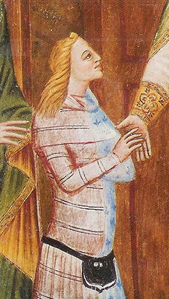
Wall painting from St. Johannchurch, Bozen. 1370
by Charles Francisk von Rafenstain
Francisk von Rafenstain was probably born around 1320, almost certainly at castle Auer near Dorf Tirol. During his youth he learned to read and write, a welcome knowledge for his life to come. The very first time we have a proof of his existence is in a document from 1357, where he is entitled with the duty of judge vicar under the Lord of Enn at the court of Gries city, Bozen.
This demands an explanation. During the medieval period, more influent knights and Lords had the duty to administrate justice over entire shires. This often resulted as an impossible task to accomplish due to the many towns and cities. So, in accordance to the Duke of Tirol’s laws, the Lords used their lower nobility or minor knights as their stewards as vicars on strategic placed courts, thus granting their allegiance through a reasonable income and proportional influence in the local social life. Francisk got such a post and had the jurisdiction over the little town of Gries. How he came to this influence, can be simply explained by the fact that he borrowed his inherited money to the right people, as the before mentioned document from 1357 states:
1357, November the 24th: Duke Ludwig of Brandenburg promises to pay back the money he borrowed through Sir Oswald Lord of Villanders, the money that “Zisk” (abbr. Francisk) of Auer had borrowed him (the Duke).
This was a perfect move. Francisk got noticed by the Duke without exposing himself to much and so being able to build a safer future for himself and his family. As hoped, the reward came in 1363, where Francisk received the title and castle of Rafenstain from the new Duke of Tirol, which descended from the house of Habsburg. He must for sure have supported the Habsburgs (Austria) against the Brandenburgs (Bavaria), or else he wouldn’t have received such a reward. Hypothetically, he could have used the reattributed money lended from the former Duke to support the new one in his fight for winning Tirol.
Ascending the ladder of local nobility and now entitled as Sir Francisk of Rafenstain, he kept on working hard as a vicar judge, more and more networking with fellow town knights from noble families. We still have some preserved records from the holy Ghost Hospital in Bozen between 1365 and 1385, which tell us a lot about the local life during that period, as well as how Sir Francisk was working.
1365, august the 29th. Francisk von Rafenstain, judge of Gries, decides about the quarrel of Martin also known as Sach and former judge of Gries against Anton the barrelmaker living on Wangergasse in Bozen, that every one owning a house and living in it, has to pay taxes for the house itself, but not for the yards around it. Only the old farms outside the city are still taxed after the old law. (Nr. 731, HGHA [Holy Ghost Hospital archives abbr.] Bozen).
1366, september the 25th. In presence of the following witnesses: Bernardi von Hurlach and judge Engellini, Pechtoldi von Wedel, Friici the guard and others.
The secretary and hospital executive, Domina Beneschruda asks once again Sir Rafenstain if he would accept audience from farmer Jacobus, also known as Wieser. The case had to be quickly resolved because of the farmers advanced age and bad health, therefore his need for help. It is about several acres of land as well as 234 litres of red wine that Sir Redlinius von Turri has stolen from his partner whom he is witness for. Sir Rafenstain postponed the session to a later date. (Shortened version. HGHA nr.736, Bozen).
The session took first place in february 1367 and the case turned up to be very complex, with difficult evidences and involving many people. (HGHA nr.741, Bozen).
1369, june the 12th. In the dispute between the brothers dominus Nicolaus and Hainricus de Turri (remember the surname??) and the builders that attend their wine yards in ladonia, suptus ecclesiam sti. Quirini prope Bozanum at one side, and the hospital and the builders, that attend its wine yards on the other side, about a tax (denarum culta seu steura) for protection barriers of tree and stone preventing over floating of the rivers Talfer and Eisack (edificium seu structura contra aquam Eysarcii et Talverne), is the hospital executive Nicolaus ex Angulo asked to attend at court session before Vicar Francisk of Rafenstain iudex provincialis ad Gries.
Five pledgers (limitatores) named dominus Arnoldus, son of c. dominus Pranthohus, dominus Vlricus prebendarius, dominus Arnoldus de inferiori Porta, Hainricus dictus Wuste and Arnoldus carpentarius decides after an inspection of the water barriers, that the hospital has to pay the brothers von Thurn (de Turri) a incentive of 40 pf. kl. (B. = Verona) due on saint John Baptist day (24th june). The payment though, releases the hospital for labor efforts. That way the matter should be solved as requested by the accuser.
Witnesses: dns.(dominus) Fridiricus dcs. (dictus) Frazzel de Velles, dns. Perlinus de Hurlach prope Bozanum, Englinius iudex civitatis Bozani, Pertrus dcs. Lölle, Johannes dcs. Slechtleiter pulcher, Nicolaus Fridlinus et Zacherlinus servitori suprascripti dni Nicolay de Turri, Merchlinus dcs. Offterus, Hainricus dcs Gauder. (HGHA nr.756, Bozen).
1370, January 16th. (HGHA Nr.764, Bozen). Francisk von Rafenstain, judge of Gries and Englin, judge of Bozen, are authorising a copy as validation for the verbally inserted document of 1368, september the 24th (HGHA nr.754, Bozen).
1371, august 29th. Albert of the outer meat marked in Bozen, son of the defunct Sir Erhard miles (knight) of Bozen, is renting Albin of Pignoet the Pignater farm (near Rentsch in Bozen) with hereditary construction rights. Curdaun and Curneyt are mentioned.
Witnesses: Sir Arnold, son of the defunct Sir Heinrich of Niedertor, Sir Heinrich von Thurn, Francisk von Rafenstain vicarius judge in Gries. (HGHA nr.779, Bozen).
1371, september 3rd. (HGHA nr.780, Bozen). Francisk von Rafenstain vicarius provincialis constitutus ad Gries and Englin, judge of Bozen, are authorizing a copy as validation for the verbally inserted document of 1327, April the 12. (HGHA nr.429, Bozen).
1372, september 3rd (HGHA nr.789) 1372, September 30th (HGHA nr.792) Those two are regarding purchase of a house and money donations to the hospital. Francisk von Rafenstain is registered as a witness in both of them.
The records from the holy Ghost hospital are furthermore enriched by som other ones from the Dominican church as well as one written by himself. The one in the dominican church reveal
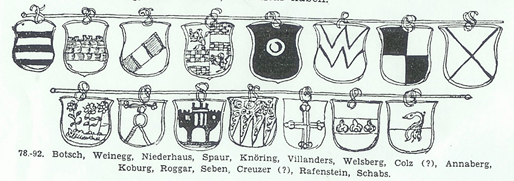
Drawing from Marx Sittich v. Wolkenstein 1620.
Sir Francisks arms can be seen on the second raw, second from the right.
1375, august 22nd. On a document regarding the rent of a house by the prominent town noble Nikolaus Vintler to Michaelis known as Kernn de Hallis and his wife lady Otilia known as Päckin, we discover that “neighbours, above, Francisk von Rafenstain. Below sir Adelperius of Tridento.” (Nr.813 HGHA, Bozen).
‘Above’ and ‘below’ are to be understood as the house before and the house after. Another evidence cross-proofs the fact that he bought these two houses is mentioned in a very interesting document of 1385, telling about 10 years of tax payment as house owner in town. The story of these two houses is not finished at all. What happened in these houses up to 1385, will be revealed later on in this biography.
The size of the buildings can be measured from the house standing today and their shape determined by the oldest city map from Bozen, dating from 1607. The two houses had a width only of six metres and a depth of approximately of 20 metres. The ground floor with the main entrance on the front, and the cellar door at the rear, facing small farming gardens, a first floor and an upper floor ending as an attic and covered with a saddle type roof made of wooden tiles. Last described depth, stories and roof are as mentioned taken from the drawing of 1607 and there is no proof that it might have looked exactly the same in 1375.
1373, one day a year to pray for Francisk von Rafenstain. (Ztschr. d. Ferd., 1845, 1.c.).
This was common tradition for nobles about to enter advance age. Typically by paying a good amount of money in form of charity donations to the church, the priests nominated
one day where all prayers to God where regarding the good health and longevity of the sponsoring person. Already here, we have the certain prove that sir Francisk would chose this very church as his last resting place. First of all, almost all local knights he knew had their relations buried there, second the Dominicans always were the nobility’s favorites in contrast of the burghs that chosed the Franciscans. Thanks to this donation, we discover for the first time how sir Rafenstain’s coat of arms looked like. His coat of arms was painted on the cloister wall and drawn by Marx Sittich von Wolkenstain in the 16th century (Cultura Atesina, V/1951,
1374, may 25th.I, Francisk of Rafenstain declare for me and my inheritant to the public through this letter for all whom sees, listen, or reads it, that my Lord, sir Kasparen has approved the account i have sent to him and together we have closed the dept of his defunct father, for his sake and for his brothers sake and for sir Kasparen’s sake. Hereby none of them owes either me or my inheritant any longer. Neither me or my enheritant will request gold from sir Kasparen or his enheritant, or his brother, regarding the debt of his defunct father from todays date on. In addition to this, I, before mentioned Francisk of Rafenstain or my enheritant declare that we do not possess any document about the debt in gold amount that the defunct Sir Pechtold, or Sir Hans, or Sir Kaspar owes us, any longer. Therewith the debt certificate shall be destroyed and to prove all this, I write this document in truth to all present and give it to Sir Kaspar and his enheritant, sealed with my own seal. Witnesses are: Earl Pertold von Sulz, Sir Eckhart von Trasperg, Sir Friedrich von Greiffenstain, Sir Jacob von Villanders, Sir Chunrad Pranger, Sir Kasper von Firmian, Jörig called Sebner, and inheritants of them all in sufficient number. This is written after Christ birth, threehundreth year in the seventieth and fourth year of the second day of pentecost after pentecost. (Tyrolean Land archive document II/1064).
The two houses in Bozen city.
The following year, Francisk results already as the owner of two houses on today’s fruit and vegetable market, called the upper market in that period. Both houses where located side by side at todays number 30/31, but pulled down in the 18th century in order to build the one that stands today, as shown in the picture. (TLA, fol.23, plus Hoeniger, Schlern Schrift 92/1951, s.39 Anm.51, plus previous owners mentioned in HGHA: nr.118, 1295 sep. 19th; nr.354, 1321 nov. 8th; nr.625, 1348 jun 12th; nr.651, 1351 june 28th).
How the two houses looked like in 1375.
The most honest answer to this question would be that we do not know it exactly, but we have different sources bringing us very close to how they would have looked like. First of all the houses are described in the documents as “House with cellar and stone walls”. In addition to this, we also know for sure that the previous owners mentioned above, got them on life rent from the Holy Ghost hospital and had subsequently to keep them well maintained at all times.
This continued on until 1348 where a fire destroyed them (consequences of the plague?) and the hospital passed them with hereditary benefit to new owners under the condition that they had to be rebuilded as they looked like originally, this though in exchange for a lower hereditary benefit rent. (From 20 Pf. Down to 5 Pf. a year). One was given to Rueblinus the Goldsmith in 1348 and the other to Bellischerius (Welenscherus) the chemist in 1351. (Nr.625 and 651, HGHA).
What happened between 1351 and 1375 when Francisk von Rafenstain bought both houses is yet unknown and the actual document of the purchase itself is still missing.
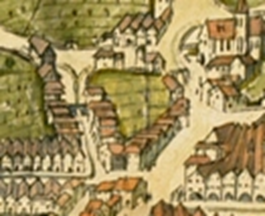
First drawing of the two houses owned by Francisk They are nr. 4 and 5 in the right side of the “V”houses . Formation in the centre of the picture. Pfendter, 1607.
1375, august 22nd. On a document regarding the rent of a house by the prominent town noble Nikolaus Vintler to Michaelis known as Kernn de Hallis and his wife lady Otilia known as Päckin, we discover that “neighbours, above, Francisk von Rafenstain. Below sir Adelperius of Tridento.” (Nr.813 HGHA, Bozen).
‘Above’ and ‘below’ are to be understood as the house before and the house after. Another evidence cross-proofs the fact that he bought these two houses is mentioned in a very interesting document of 1385, telling about 10 years of tax payment as house owner in town. The story of these two houses is not finished at all. What happened in these houses up to 1385, will be revealed later on in this biography.
The size of the buildings can be measured from the house standing today and their shape determined by the oldest city map from Bozen, dating from 1607. The two houses had a width only of six metres and a depth of approximately of 20 metres. The ground floor with the main entrance on the front, and the cellar door at the rear, facing small farming gardens, a first floor and an upper floor ending as an attic and covered with a saddle type roof made of wooden tiles. Last described depth, stories and roof are as mentioned taken from the drawing of 1607 and there is no proof that it might have looked exactly the same in 1375.
Obstmarkt 30/31. The green painted house build on the fundaments of Rafenstain’s medieval houses and dates 19th. century. Picture taken by Armin Toggler
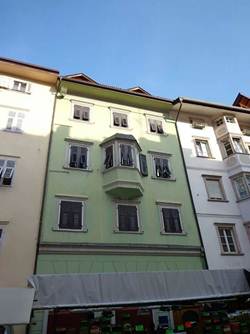
Stabilizing property and social status.
In 1380, five years after the purchase of the two houses, the duke Leopold of Habsburg confirms the ownership of the castle of Rafenstain along with all the benefits and title to sir Francisk. This must have been a big issue and nevertheless a clear evidence of sir Francisks loyalty towards the House of Habsburg. (Regest briefl. Gerechtigkeiten 1620, 1.c.)
His attempt for stabilising his future and social status is furthermore underlined by his son Daniel membership in the brothership of Saint Christopher on the Arlberg, a union of knights loyal to Habsburg with the purpose of defending hegemony over the trade roads to Switzerland and France. (Ztschr.d.Ferd.,11/1845, page 114).
Out of the preserved evidences in the documents, speculations might lead to the hypotheses that Francisk tried to prepare a future for his son. He tried to get well renowned among the local nobility and purchased two houses that might have served the purpose for his son keep up with the times fashion of “town knights”, where commercial prosperity gave notable influence in the game of marriage between other nobles of equal status.
The big blow – from judge to convicted.
The year is 1385 and ten years have passed since Francisk bought the two houses in the town of Bozen. The houses must have been more comfortable then the castle, so he moved into them and lived as a town knight enjoying all privileges of his noble status. In the same period, the merchants class economic influence arose rapidly thanks to the prospering business, thus leaving the lower nobility increasingly poorer. Money means power and this was the main reason for the unfortunate situation Francisk got in.
The merchants and citizens of Bozen wrote on several occasions to the bishop of Trento city (Bozen city sales taxes went to him, since the church owned the rights), complaining about the knight Francisk von Rafenstain staying in the city, but never paying the mandatory yearly tax as all the other residents. This went probably on over a whole decade until in 1385, where the matter culminated and the Stewart of Tirol, Lord Heinrich von Rottenburg called both the town merchants and Francisk von Rafenstain in to a court trial. This was the very first time in Tyrolean history, where commoners convicted a noble in court. Obviously, the court session was attended by almost all local knights in defense of Sir Francisk on one side and the most influential city merchants on the other. An exact translation of the trial protocol gives the best idea about this important moment. By reading it, we get a very lively impression of the mood and the persons involved.
1385, march the fifth, Bozen. (Taken place in the monastry of the barefooted monks, franciscanians).
On a court session day held by Lord Heinrich of Rottenburg of Tyrol and Steward of the Etsch and the bishopric of Trento in the name of Duke Leopold III of Austria and the bishop Albrecht of Trento, appears Sir Oswalt, stewart of the bishop, and the citizens of Bozen to rise complaint against Francisk von Rafenstain with following accusation: The bishop of Trento demands yearly 100 Mark Berner (Verona), Meraner coins as tax from the citizens of Bozen. The citizens of Bozen used their own tax documents as proof for their own acusement against Sir Rafenstain. This was stipulated from both the duke of Austria as well as the bishop of Trento, that Sir Francisk von Rafenstain has to be accused because:
He owns houses in the city and lives in them, stores his wine in them and even sells it. Despite that, Sir Francisk has refused to pay any tax in the last ten years.
Sir Francisk defends himself by answering the accusers:
I own a castle outside this city called Rafenstain, where I live and neither me nor my ancestors have ever paid taxes. But if a campaign arises, I will serve the dukedom with shield and spear, like any other Knight and squire and if I am too old for that, I will send my son to battle instead and therefore I shall not pay any taxes like the commoners do. In addition to that, the wine I keep in my cellars in the houses is for storage and comes from my wine yards around the castle. I have offered a drink only to the citizens of Bozen and to nobody else.
Asking what is right to decide, Sir Arnold von Niedertor of Bozen, in accordance with the jury, decides that Sir Francisk von Rafenstain does not need to pay the ten years of tax retributions as long as he moves out of the city and back to his castle and never again stores his wine in his houses or makes business of any kind in the city. If he does not respect this, he will be forced to contribute in tax payment along with all the other citizens of Bozen.
The bishops steward, Oswald, and the citizens of Bozens demands a sealed document with the verdict from the judge.
Witnesses: Lord Marghard the country preceptor of the Teutonic Order, Sir Paul von Twingenberch, Sir Hainrich von Chäle, Sir Hartmann von Schaim, Lord Hans of Villanders also called von Pradl, Sir Volkmar von Maretsch along with all knights, Sir Arnold von Niedertor, Sir Lienhard von Boymont, Sir Raicher von Liebenberg, Sir Hainrich von Thurm of Bozen, Sir Jacomel von Sand Can, Stewart at Kunigsberg, Cristoffel von Fuchs of Eppan, Sir Blasy von Perneck, Sir Hainrich, Sir Hans and Sir Cristoffl, all three von Botsch, Sir Hans von Weineck, Sir Nikel von Vintler, country jugde of Gries near Bozen (ironically Sir Francisks former office!!), Sir Pertle von Luntzer, Captain on castle Stain on Ritten and other honest witnesses.
The trial must for sure have been a blow for Francisk, but thanks to it we are able to deduct the following facts from 1385:
- He was old
- He had a son fit for war service
- He owned greater wine yards and therefore had several peasants to work for him
- The houses in Bozen had for sure cellars
- He was in economic trouble, since he tried to sell wine
- He had definitely no sympathy for the bishop of Trento
- He was known to almost all local nobility.
Sir Francisk must have passed his last two years on the castle where he finally died the 8th. December 1387. He was buried in the chapel of Saint Nikolaus in the Dominican church in Bozen, as the drawing of Marx Sittich von Wolkenstein still witnessed in 1620, picturing his death-coat of arms in the cloister. (Cultura Atesina, V/1951, s.78 f.)
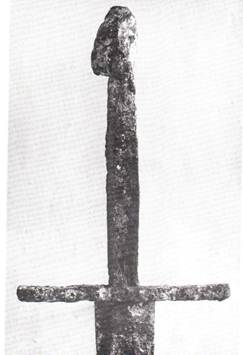
Unfortunately, the chapel has been demolished in 1820 and its basement used as foundation for enlarging the street running parallel to the church central nave. Basically no records about the existence of the grave until 1987, when archaeological excavations brought three of the many graves back to daylight again. Two of them where located in the chapel walls and one in the floor. The first wall grave contained a male skeleton with a skeleton of a child at his feet. In the same grave a two-hand sword was found dating 1470-1520 along with two iron spurs of the same period. Wall grave number two was empty. The third grave, the one on the ground, contained skeleton remains and a sword measuring 117×17.4cm from the period 1350-1380. The sword is quite simple and would match the life period of sir Francisk. The only sad fact we know for sure is, that sir Francisks last resting place today lies under a very trafficked street.
9 years after his death, castle and houses passed onto his son Daniel in 1396, that died unfortunately already in 1398. After his death, the nobles of Goldeck inherited the castle. The circumstances leading to Daniel’s death are unknown, but we can guess that it wasn’t because of old age, because he died shortly after his father. There are no records of plaque outbreaks during this year, so that can’t be the cause either. It can’t be war, since no battles demanding his participation, took place.
Daniels death could possibly have been caused by a disease, accident or murder. Anyhow, we don’t know where Daniel was buried, since no record or evidence whatsoever proves that he was buried the same place as his father
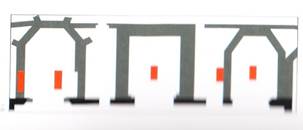
The st. Nikolaus chapel (1st. on the left) before it got demolished in 1820.
The redsquares indicate the wall graves and the grave in the pavement.
From: Die Dominikaner in Bozen, page 100, Stadt Bozen Verlag.
The name of the rose.
The reader of this biography has probably wondered who the wife of sir Francisk was. At this stage of researching we do not know it yet, but there are a few believable theses.
She almost surely died of plague or by giving birth to Daniel and this would set the year of her death approximately between 1347 and 1350.
One thesis point are the Goldeck family, mainly because this family succeeded Rafenstain. In order to discover if that might be true, the whole Goldeck family three has been reconstructed after the records collected from Mayerhofen in the 19th century. The results came to a dead end. Later it was discovered that Mayerhofen genealogical research had plenty of missing bits and that the original parchments came to daylight in Trento. These parchments are still under study this very moment and we hope for a brake through.
The second thesis suggests that she might have been from the Schinlin, or Schinlein family from Kaltern, since this family held the castle up to 1363 where sir Francisk took it over. Conrad Schinlein should got permission to renew the castle from the former duke Ludwig von Brandenburg in 1358, (TLA Lehenurkunden A.146, 1358 I 3.) but he is recorded as dead already in 1368. (Nr.748 HGHA, Bozen). The erroneously believe that Conrad Schinlein should have got permission from the duke to build a “house on top of the castle hill” derives from Burglechner (Tiroler Adler III, s.504) and has no relation to the original document whatsoever. Conrad Schinlein could have been sir Francisks father in law, but we don’t know the entire Schinlein family three yet and therefore came to a dead end here as well.
The third thesis leads to the guess that the mysterious woman’s identity could be revealed by analysing the Auer family three, since they were sir Francisks relation before he got entitled with thr name von Rafenstain by the duke. The family of Auer still exists and has been contacted, but they could not provide any useful informations for the case and most historical records are spread among thousands untranslated ones, still dwelling in the archives of Innsbruck.
The fourth thesis is that Francisks wife is buried along with him in the Dominican church in Bozen.
All the information about the graves in the church are based on wall paintings, archaeological excavations and historic records. Of all the names and possible connections only one could be a positive match: Chiara von Jaudes (died in 1349). Unfortunately, this has also to remain a thesis, because there is no proof of any connection among them at all.
The fifth thesis is that her name was Kathrine von Villanders, daughter of Sir Oswald of Villanders, Lord of Enn. Why else should Francisk lend him money so he could lend them on to the duke? (see this biography year 1357).
The first biography about Sir Francisk von Rafenstain was written in 2008 and contained not even half of the informations compared to this new edition. Its my hope that we are able to make a third edition faster than the previous one, containing the unsolved answers to most of the questions regarding the life of this remarkable knight.
Literature index:
– Trapp, Oswald; Tiroler Burgenbuch Band 5-Sarntal, Athesia Verlag 1981.
- Obermair, Hannes; Bozen Süd – Bolzano Nord, Band 1 + 2, Stadt Bozen Verlag, 2005.
- Stampfer Helmut und Pintarelli Silvia; Domenikaner in Bozen, Stadt Bozen Verlag, 2010.
- Weingartner, Josef; Tiroler Burgenkunde, Margarete Friedrich Rohrer Verlag, 1950.
- Langes, Günther; Burggrafenamt und Meran, Athesia Verlag, 1978.
- Mahlknecht, Bruno; Bozen durch die Jahrhunderte, Band 1, Athesia spectrum Verlag, 2005.
- Neubecker, Ottfried; Heraldry, sources, symbols and meaning; Little Brown co. 1988.
